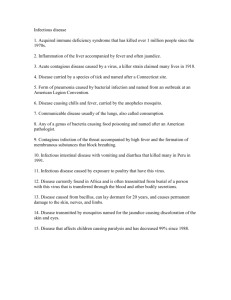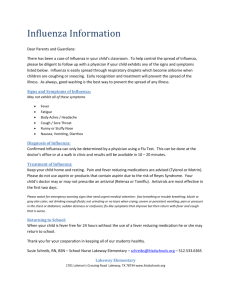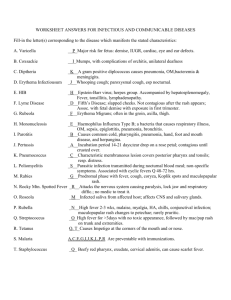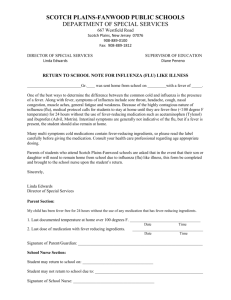emergency preparedness: bioterrorism
advertisement
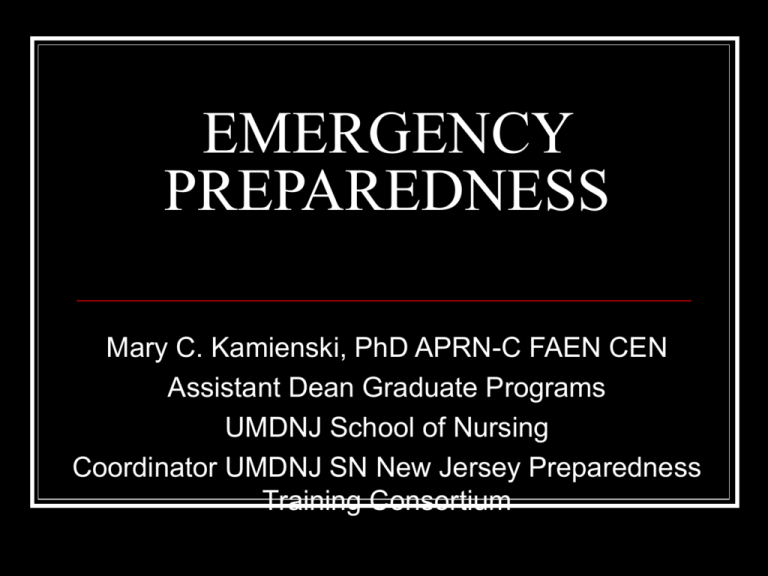
EMERGENCY PREPAREDNESS Mary C. Kamienski, PhD APRN-C FAEN CEN Assistant Dean Graduate Programs UMDNJ School of Nursing Coordinator UMDNJ SN New Jersey Preparedness Training Consortium OBJECTIVES Review the role of the school nurse in bioterrorism emergency preparedness Identify the threats to children in a bioterrorist attack. List the biochemical agents that might be used. Discuss development of a plan for preparedness. Cycle of Crisis Planning Mitigation & Prevention (Reduce or eliminate risk to life & property.) Preparedness (Plan for the worse case scenario) Recovery Response (Restore the learning & teaching environment.) (Steps to take during a crisis) National Association of School Nurses Position Statement School Nurse Role in Bioterrorism Emergency Preparedness School nurses are the first responders Requires proactive & comprehensive training of school nurses Role of School Nurse Surveillance & pattern recognition Assess potential emergency risks Assess adequacy of emergency trainings & practice activities Position on the front line Detailed knowledge of children’s needs Assist in short and long-term recovery phase Objectives for this lecture will be to focus on preparedness. Education Collaboration Contacts Getting started What if it really happens? Types of Emergencies Chemical Biological Radiological Nuclear/ Explosive Hurricanes/Floods/Snow/Blackouts Pandemic Influenza Children at Risk: Targets Innocent, vulnerable population Tend to gather in large groups such as schools May not be able to rescue themselves Extreme emotional reaction by rescuers and public Are you ready? It is the middle of the winter Influenza cases are climbing Staff is calling in sick 30% of the staff is out Illness reported in children and adults. Influenza Normal season Dec. - March 36,000 excess deaths annually > 110,000 excess hospitalizations Pandemic 35% of the population will become infected Most of the impact within a 4 – 8 week period Pandemic Stages Phase 1-2 : No New Influenza virus subtypes detected in humans Phase 3-4: No (or very localized) human to human transmission *Alert Period* Phase 5: Large clusters of human to human transmission *Heightened Alert Period* Phase 6: Increased or sustained transmission in the general population Populations affected Normal Influenza Older population Immune compromised Infants and children Pandemic Influenza Infants and Children Immune compromised Older population Competency Competency is is a term used to signify specific abilities, skills, talents, knowledge and understanding that they are components of individual behavior It is the quality of being functionally adequate in performing activities and assuming the role of a specific position with the requisite knowledge, ability, capability, judgment, attitudes and values American Nurses Association. Standards of Community Health Nursing Practice. Kansas City, Mo.: 1973 Competencies Describe the chain of command in an emergency Identify and locate the emergency plan Describe his/her functional role(s) in an emergency response Demonstrate that role in regular drills Demonstrate correct use of all communication equipment may be used in an emergency Describe communication role(s) in emergency response National Incident Management System Authorized by the President in 2003 Improve the coordination and cooperation among all response organizations Flexible framework to support agencies working together regardless of the size location or complexity of the incident Incident Command System Tool to command, control and coordinate a response to an event or incident Federal law requires its use for all Hazardous Materials incidents Many states use ICS as the response standard for all types of incidents ICS Core Functions Command Planning Operations Logistics Administration Finance Influenza Normal season Dec. - March 36,000 excess deaths annually > 110,000 excess hospitalizations Pandemic 35% of the population will become infected Most of the impact within a 4 – 8 week period Pandemic Stages Phase 1-2 : No New Influenza virus subtypes detected in humans Phase 3-4: No (or very localized) human to human transmission *Alert Period* Phase 5: Large clusters of human to human transmission *Heightened Alert Period* Phase 6: Increased or sustained transmission in the general population *Pandemic Period* Populations affected Normal Influenza Older population Immune compromised Infants and children Pandemic Influenza Infants and Children Immune compromised Older population Disaster Assessment Checklist Learn what elements of a disaster plan are in place Equipment status of the health center Education and training needs Is the health center integrated into community planning efforts of the health department and emergency service providers Competency Competency is is a term used to signify specific abilities, skills, talents, knowledge and understanding that they are components of individual behavior It is the quality of being functionally adequate in performing activities and assuming the role of a specific position with the requisite knowledge, ability, capability, judgment, attitudes and values American Nurses Association. Standards of Community Health Nursing Practice. Kansas City, Mo.: 1973 Competencies Describe the chain of command in an emergency Identify and locate the emergency plan Describe his/her functional role(s) in an emergency response Demonstrate that role in regular drills Demonstrate correct use of all communication equipment may be used in an emergency Describe communication role(s) in emergency response Children are at risk because… Low to ground Faster respiratory rates Larger skin surface area to mass ratio Vulnerable to fluid losses Unable to escape Found in large groups (contagion) Children have unique treatment needs Different sized equipment Different dosages of medications Children have unique mental health needs Reactions to disaster will vary greatly Influenced by the emotional state of the caretakers Terrorist Event Characteristics* Lack of warning Lack of familiarity with type of event Sudden contrast of scene; abrupt change in reality Serious threat to personal safety * From Weapons of Mass Destruction and Terrorism: Mental Health Consequences and Implications for Planning and Training. Diane Myers RN, MSN, www.icisf.org Is your community at risk? Major trade, banking or retail centers Historic landmarks Military installations Colleges/schools Manufacturing plants Chemical storage centers Is your community at risk? Governmental buildings Major sports, entertainment, and convention venues and events Technological research centers Airports, other transportation and import/export centers Religious centers Pediatric Venues at Risk Schools near potential target areas Hospitals Facilities with children with special needs and low self-rescue capabilities We must talk to our children about terrorism Children will suffer psychological consequences from disasters and terrorism Children Need to Know What to do if they find an unidentified package or substance How to look for safe places and escape routes Not to be afraid of rescuers The importance of school disaster drills Talking about Terrorism Children less than about 5 yrs of age will not understand in advance that something might happen Children over 5 years of age will be very aware of anything in the media and may start to understand that something might happen Talking about Terrorism 5-9 yrs of age Some people are angry at our country Even though ordinary people didn’t do anything to deserve it, the angry people want to make Americans sad and afraid as punishment Punishing innocent people is wrong Talking about Terrorism 5-9 yrs of age Our country will stop those who hurt and kill innocent people Many people are working to keep us safe They are safe It’s OK to be afraid, even if they hear others say we shouldn’t be afraid If they are very afraid or sad, they should tell someone and not hide their feelings Talking about Terrorism 9 yrs and older Can begin to discuss “politics”, including why people and countries may disagree Discuss why one type of people may think others are “evil” Discuss why helpless people can be influenced by terrorists to help them achieve their goals Talking about Terrorism 9 yrs and older “Terrorism is the language of the powerless”: why we must not only fight terrorists but also help those they might dominate Talk in general about the different things terrorists might use as weapons Emphasize that they are safe and most aspects of our lives will remain normal Caution children about rumors BE PREPARED Educate Educate Educate Educate yourself the children the parents other personnel Weapons of Mass Effect: Chemicals Nerve agents Vesicants Chlorine, Bromine, Ammonia Choking Agents Mustard gas, Lewisite Irritants/Corrosives Sarin, Tabun, Soman, VX Phosgene Cyanogens WME: Biologicals Bacteria Rickettsia Anthrax, brucellosis, botulism, tularemia, plague Q fever, epidemic typhus, RMSF Fungi Coccidiodomycosis WME: Biologicals Viruses Smallpox, hemorrhagic fevers, equine encephalitides, yellow fever, hantavirus, ebola Toxins Aflatoxin, botulinum toxin, Clostridium toxin, ricin, shiga toxin, staphylococcal enterotoxin, tetrodotoxin HCN & CICN (hydrogen cyanide & cyanogen chloride) Colorless-to-pale yellow liquid turns into gas at near room temperature Bitter almonds (HCN) acrid choking odor (CICN)- burns eyes Nausea, vomiting, palpitations, confusion, hyperventilation, anxiety, vertigo, agitation, stupor, coma, death Leave the area – get treatment STAT Mustard Gas Contact & a vapor hazard Clear to dark brown Garlic-like odor Liquid to gas as temperature ⇪ Mild skin irritation to more severe yellow fluid-filled blisters Respiratory difficulties when inhaled Death by suffocation S&S within 2 to 24 hours Tx is available Sarin Clear, colorless, tasteless, no odor Disrupts nervous system by blocking nerve signals Skin, eye, respiratory contact, ingested Constriction of the pupils, salivation, convulsions, death Medical tx STAT Can evaporate into a vapor (gas) & spread into environment RICIN Poison made from waste from processing castor beans Powder, mist, or pellet dissolved in water or weak acid Stable substance Inhalation or ingestion; injected Not contagious Moves into cells and prevents protein synthesis Ricin……. Inhalation – coughing, chest tightness, dyspnea, nausea, aching muscles to pulmonary edema and cyanosis Ingestion – GI bleed; vomiting & bloody diarrhea; renal and hepatic failure; death Injection – muscle & lymph death; hepatic and renal failure; massive GI bleed; death from MOS failure VX Human-made chemical – nerve agent Odorless & tasteless; oily liquid; amber and slow to evaporate-high temperature can turn to vapor Exposure through skin or eye contact, inhalation or ingestion Clothing can release VX for about 30 “ Breaks down in body slowly S&S same as Sarin No long term effects is survive Tx same as Sarin Food borne botulism….. 6 hours to 2 weeks (12 to 36 hours) Double vision, blurred vision, drooping eyelids, slurred speech, dysphasia, dry mouth, muscle weakness (descending) to paralysis Not spread Antitoxin available Pneumonic Plague Infectious disease of humans & animals Found in rodents & fleas Destroyed by sunlight & drying Survives for 1 hour if released into air Septicemic when bacteria multiply in the blood; no buboes; does not spread. Pneumonic affects lungs spread thru air Bubonic most common when the affected flea bites human swollen, tender lymph nodes (buboes), fever, HA, chills, & weakness Does not spread from person to person First signs are fever, HA, weakness, rapidly developing pneumonia, SOB, chest pain, cough, bloody or watery sputum; progresses for 2 to 4 days Antibiotic treatment No vaccine available for use in USA Smallpox Serious, contagious, sometimes fatal infectious disease No specific treatment Vaccination is only prevention Variola major most severe and most common with extensive rash & higher fever Variola minor – less common & less severe Last case in USA in 1949 Last naturally occurring case in the world in Somalia in 1977 Except for laboratory stockpiles the variola virus has been eliminated Transmission is direct and requires fairly prolonged face-to-face contact Direct contact with infected bodily fluids or contaminated objects Only human transmission Contagious with onset of fever (prodrome phase) until last scab falls off RASH Starts as small red spots on the tongue and in the mouth Develop into sores that break open and spread the virus (most contagious time) Skin rash starts on face and spread to arms & legs and hands & feet within 24 hours Third day the rash becomes raised bumps Fourth day bumps fill with a thick opaque fluid with a depression in the center (like a bellybutton) Fever rises again until scabs form over bumps More rash….. Bumps become pustules (feel like BB pellets under the skin) (5 days) End of 2nd week most sores scabbed over (5 days) After three weeks most scabs will have fallen off (6 days) Scabs are resolved and no longer contagious Smallpox Vaccine Made from live vaccinia virus US stockpile to vaccinate everyone in the country High level immunity for 3 to 5 years Can prevent or substantially lessen infection if given within a few days of exposure Administered with bifurcated needle that is dipped into vaccine Usually in upper arm Red, itchy bump in 3-4 days > large blister > fills with pus > begins to drain > dries > scab forms > 3rd week scab falls off > small scar Side effects Sore arm, fever, & body aches Should not get vaccine: Skin conditions such as eczema or atopic dermatitis weakened immune systems Cancer tx or steroids Pregnant or lactating women < 12 mos old < 18 years unless emergency Temporary exclusions Cardiac disease Strokes, TIAs Diabetes HTN High cholesterol Currently a smoke Risk 1 in 1,000,000 may die Careful screening ANTHRAX Acute infectious disease Spore-forming bacterium Occurs in hoofed animals and humans Symptoms vary but occur within 7 days of exposure Cutaneous, inhalation, intestinal Inhalation may resemble a common cold symptoms progress to severe respiratory distress & shock often fatal Intestinal disease from ingestion acute inflammation of GI tract nausea, anorexia, emesis, fever, abdominal pain, hematemesis, severe diarrhea Person-to-person unlikely Cutaneous direct contact with bacterium main form worldwide – 95% all cases Within 2 weeks itchy skin lesion develops (insect bite) May blister and break down > black painless ulcer surrounded by edema A few may have fever, HA, malaise Lymphadenopathy may develop Often scars – dries and falls off within 2 weeks Treatment Early oral antibiotics PCN, doxycycline, ciprofloxacin (used if outbreak is suspected) Prognosis Excellent if treated 20% fatal if untreated Developing Crisis Plans Tailor plans to meet individual school needs Plan for diverse needs of children & staff Open communication use a common vocabulary Collaboration Develop plans with other community groups law enforcement fire safety officials EMS mental health professionals hospitals Civil Defense Access to plan Teachers & staff need ready access to the plan Training and practice are essential Establish links with emergency responders in the community Educate students and parents about the plan DO NOT REINVENT THE WHEEL Adapt an existing plan to meet the special needs in your school and your school district. Review the plan Has everyone been involved in planning? Are there procedures for communicating with staff, students, families, & media? Are there procedures to account for students during a crisis? Is there necessary information in one spot such as maps, utility shutoffs, rosters, attendance records? Is the necessary equipment available to assist the staff in a crisis? Some Useful Resources www.cdc.gov (Centers for Disease Control and Prevention) www.whitehouse.gov/homeland (Office of Homeland Security) www.fema.gov (Federal Emergency Management Agency) International Critical Incident Stress Foundation @ www.icisf.org EMS-C National Resource Center @ www.ems-c.org American Academy of Pediatrics @ www.aap.org www.TimeforKids.com “During the 16 days of the rescue endeavor on the Murrah Building, the building ceased to be a symbol of horror and became a symbol of the power of good as being stronger than the power of evil.” Chief Jon Hansen, Oklahoma City FD As Time Goes On May expect…… Regressive behaviors Sleep disturbances Fatigue Unusual expressions of anger Changes in appetite Mood swings Lack of ability to experience pleasure Substance abuse Recovery Plan Return to learning ASAP Restore the physical plant prn Monitor staff and students Conduct debriefings Assess curricular activities that address the crisis Make time for recovery Plan anniversary of event activities Capture “lessons learned” and revise the plan and retrain
